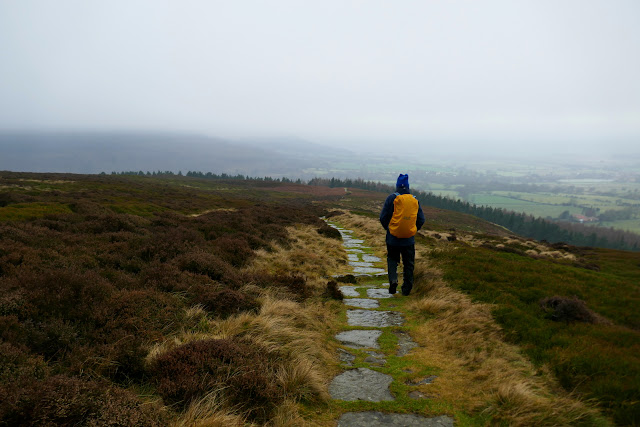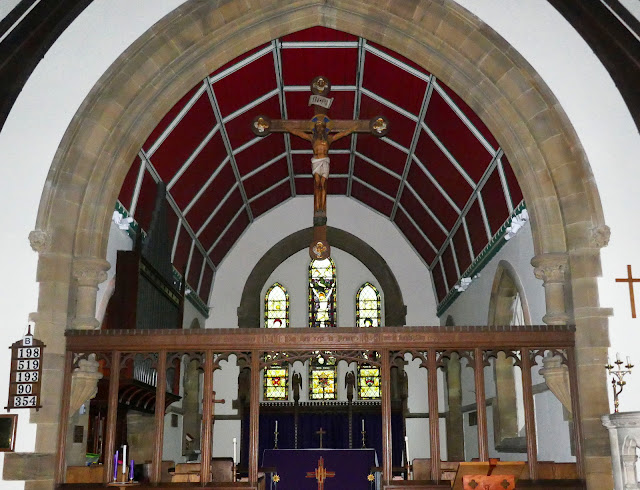Whorlton Castle and Church from Swainby
6 miles Cold, wintry showers
We parked in the road at Swainby near the Blacksmith's Arms and before crossing the river we looked at the restored pinfold just opposite the pub. A pinfold is where stray animals were kept secure until they were reclaimed by their owners after payment of a fine.
 |
| Today's walk from The Walker's Guide to the Cleveland Hills |
 |
| Pinfold |
We then walked up the high street and turned left into a footpath just before the church.
This footpath passes along the back of houses and we soon left Swainby, which Tom Scott Burns informs us means 'Swain's Farm', from the old Norse name Sveinn.
 |
| Swainby High Street |
 |
| Footpath to Whorlton |
 |
| Mining weather vane at Swainby |
The footpath soon joins a lane which took us very quickly to Whorlton Castle. All that is left to see of the castle is the gatehouse and we were disappointed to see that, unlike previous visits, this was securely locked, preventing access to the rest of the ruin.
 |
| Whorlton Castle Gatehouse |
 |
| Keep Out! |
We continued a few yards further along the tarmac lane to the old Saxon church of Holy Cross. There is a tale that an underground passage links the castle to this nearby church and we decided to stop off to have a look round. The church was locked and we peered through the grill in the chancel door. We could just see the bog oak effigy of the second Lord Nicholas de Meynell who died in 1322.
 |
| Holy Cross Church |
 |
| Rear of church |
 |
| See below |
On the rear wall are two shields with coats of arms. One is nearly illegible but the other with three hands is the coat of arms of Bate of Easby. (see here for further information about the church and castle)
Walking round to the rear of the church we were pleased to notice a medieval 'Mass Dial'. In days when the majority of people were illiterate these would be sited on the south wall of a church and a wooden peg (called a gnomon) would have been placed in the top hole. The Mass Dial worked as a sun dial, the shadow reaching the bottom holes would indicate the approximate times for mass. (see here for more about mass dials)
 |
| Mass Dial |
 |
| Bog oak effigy |
 |
| 'In perfect hilth he went from home, and little thought his glass was run, but dying in so short a space, I hope his soul in a good place' |
As we left the church we met the vicar who told us he was there to meet a stone mason. He explained that he was the vicar of the new Benefice of Whorlton, which covers Carlton, Crathorne, Faceby, Middleton, Potto, Hutton Rudby, Swainby and Whorlton. It took the name Benefice of Whorlton despite Whorlton having no parishioners, because that is the oldest of the churches.
He told us that no-one really knew what had happened to the residents of deserted Whorlton. They probably upped and moved to Swainby following a disaster, such as plague. We asked if he knew why the castle gate house had been locked and he said the church and castle had been plagued by Ghost Hunters using electrical devices, but didn't think that would be the reason - more likely it is to prevent vandalism.
We said cheerio to the vicar and returned to the lane and followed it to the junction with Whorlton Lane, where we climbed a stile into fields and headed straight towards Whorl Hill, which dominates the skyline. The field paths were not as muddy as we had expected considering all the recent rain. Perhaps today's bitterly cold wind had dried them somewhat.
 |
| Whorl Hill |
 |
| Leaving the lane to enter fields |
 |
| Looking back at Holy Cross and the Castle |
A steady climb took us into the trees of Whorl Hill (old Norse 'hvirfill' - 'high hill with a rounded top') and we continued to climb until our track levelled out and we circumnavigated the hill, just inside the tree line.
TSB informs us that in 1810 one of Britain's largest hoards of Roman silver coins (weighing 2 stones) was dug up on Whorl Hill by a local farmer whilst ploughing his field. We followed the path with a fine view down to Swainby through the trees, until we dropped away from the main path to exit the woods at Bank Lane via the garden of a bungalow.
We now walked up Bank Lane towards Live Moor and Round Hill. Reaching the trees of Faceby Plantation a short sharp climb brought us to a path below Round Hill, and here, sheltered from the wind, we sat to enjoy our coffee and scones using the old stone wall as seat and table.
Our break over, we climbed once more to reach the moor top and the stone flags of the Cleveland Way. We turned right and walked into a cold head wind, following the Cleveland Way westwards.
We crossed Round Hill then dropped steeply down to Huthwaite Green. Wind and sleet made this part of today's walk a bit of an ordeal and we were pleased to drop down from the moor.
Leaving the church our walk took us past the Black Horse and we finished the day with a couple of pints while watching the bar staff decorate their Christmas tree.
 |
 |
| Potto in the distance from Whorl Hill |
 |
| Climbing Whorl Hill |
 |
| Circumnavigating Whorl Hill |
 |
| Emerging in Bank Lane |
 |
| High Farm, Bank Lane |
We now walked up Bank Lane towards Live Moor and Round Hill. Reaching the trees of Faceby Plantation a short sharp climb brought us to a path below Round Hill, and here, sheltered from the wind, we sat to enjoy our coffee and scones using the old stone wall as seat and table.
 |
| Climbing through Faceby Plantation |
 |
| Reaching the moor gate |
 |
 |
| That look a good spot for lunch! |
 |
| 'It doesn't have to be fun to be fun' |
Our break over, we climbed once more to reach the moor top and the stone flags of the Cleveland Way. We turned right and walked into a cold head wind, following the Cleveland Way westwards.
 |
| Climbing to Live Moor |
 |
| Cairn on High Moor |
 |
| The cairn is on a burial mound |
 |
| Whorl Hill below |
 |
| Bleak walking on Round Hill |
 |
| The trees of Huthwaite Green appear below |
 |
 |
| Steep descent into Scugdale |
We crossed a ford and climbed across a field, still following the Cleveland Way, before turning into woods alongside Scugdale Beck. Our path led us through Clain Wood alongside the beck for a mile and looking over to the east we could at all times see Whorl Hill and our outward path.
 |
| Old railway wagon |
 |
| Crossing Scugdale Beck |
 |
| Walking through Clain Wood |
 |
| Whorl Hill over to our right |
Leaving the wood and joining the Sheepwash to the A172 road we descended towards Swainby. We entered the village walking alongside the beck and crossed the bridge to look at the new Church of Holy Cross. It was unlocked and we had a look around but there are no interesting gravestones here as burials still take place at the old church at Whorlton.
 |
| Weather vanes in Swainby |
 |
| Swainby |
 |
| The Polling Station is at the rear of Holy Cross |
 |
| Unusual suspended Crucifix at New Holy Cross |
 |
| To the rear of the church |
 |
| 'Shall we go in?' |
 |
| Cheers! |




No comments:
Post a Comment